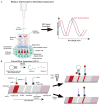Capture-SELEX: Selection Strategy, Aptamer Identification, and Biosensing Application
- PMID: 36551109
- PMCID: PMC9776347
- DOI: 10.3390/bios12121142
Capture-SELEX: Selection Strategy, Aptamer Identification, and Biosensing Application
Abstract
Small-molecule contaminants, such as antibiotics, pesticides, and plasticizers, have emerged as one of the substances most detrimental to human health and the environment. Therefore, it is crucial to develop low-cost, user-friendly, and portable biosensors capable of rapidly detecting these contaminants. Antibodies have traditionally been used as biorecognition elements. However, aptamers have recently been applied as biorecognition elements in aptamer-based biosensors, also known as aptasensors. The systematic evolution of ligands by exponential enrichment (SELEX) is an in vitro technique used to generate aptamers that bind their targets with high affinity and specificity. Over the past decade, a modified SELEX method known as Capture-SELEX has been widely used to generate DNA or RNA aptamers that bind small molecules. In this review, we summarize the recent strategies used for Capture-SELEX, describe the methods commonly used for detecting and characterizing small-molecule-aptamer interactions, and discuss the development of aptamer-based biosensors for various applications. We also discuss the challenges of the Capture-SELEX platform and biosensor development and the possibilities for their future application.
Keywords: DNA and RNA Capture-SELEX; aptamer; biosensing applications; characterization; nucleic acid aptamer; small molecule contaminant.
Conflict of interest statement
The authors declare no conflict of interest.
Figures



References
-
- Minh T.B., Leung H.W., Loi I.H., Chan W.H., So M.K., Mao J.Q., Choi D., Lam J.C., Martin M., Lee J.H.W., et al. Antibiotics in the Hong Kong metropolitan area: Ubiquitous distribution and fate in Victoria Harbour. Mar. Pollut. Bull. 2009;58:1052–1062. doi: 10.1016/j.marpolbul.2009.02.004. - DOI - PubMed
-
- Gothwal R., Shashidhar T. Antibiotic Pollution in the Environment: A Review. CLEAN–Soil. Air Water. 2015;43:479–489. doi: 10.1002/clen.201300989. - DOI
-
- Parra-Arroyo L., Gonzalez-Gonzalez R.B., Castillo-Zacarias C., Melchor Martinez E.M., Sosa-Hernandez J.E., Bilal M., Iqbal H.M.N., Barcelo D., Parra-Saldivar R. Highly hazardous pesticides and related pollutants: Toxicological, regulatory, and analytical aspects. Sci. Total Environ. 2022;807:151879. doi: 10.1016/j.scitotenv.2021.151879. - DOI - PubMed
-
- Pan W., Zeng D., Ding N., Luo K., Man Y.B., Zeng L., Zhang Q., Luo J., Kang Y. Percutaneous Penetration and Metabolism of Plasticizers by Skin Cells and Its Implication in Dermal Exposure to Plasticizers by Skin Wipes. Environ. Sci. Technol. 2020;54:10181–10190. doi: 10.1021/acs.est.0c02455. - DOI - PubMed
Publication types
MeSH terms
Substances
Grants and funding
- JCYJ20180507181642811/Shenzhen Basic Research Project
- CityU 11100222, CityU 11100421, CityU 11101519, CityU 11100218, N_CityU110/17/Research Grants Council of the Hong Kong SAR, China Projects
- 9509003/Croucher Foundation Project
- 7005503, 9667222, 9680261/State Key Laboratory of Marine Pollution Director Discretionary Fund; City University of Hong Kong projects
LinkOut - more resources
Full Text Sources
Other Literature Sources
Miscellaneous

